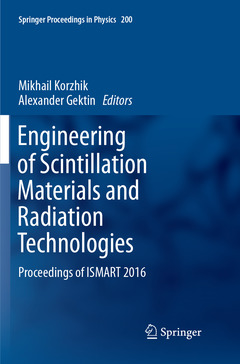Description
Engineering of Scintillation Materials and Radiation Technologies, Softcover reprint of the original 1st ed. 2017
Proceedings of ISMART 2016
Springer Proceedings in Physics Series, Vol. 200
Coordinators: Korzhik Mikhail, Gektin Alexander
Language: English
Publication date: 09-2018
Support: Print on demand
Publication date: 11-2017
Support: Print on demand
Description
/li>Contents
/li>Biography
/li>Comment
/li>
This volume provides a broad overview of the latest achievements in scintillator development, from theory to applications, and aiming for a deeper understanding of fundamental processes, as well as the discovery and availability of components for the production of new generations of scintillation materials. It includes papers on the microtheory of scintillation and the initial phase of luminescence development, applications of the various materials, and development and characterization of ionizing radiation detection equipment. The book also touches upon the increased demand for cryogenic scintillators, the renaissance of garnet materials for scintillator applications, nano-structuring in scintillator development, development and applications for security, and exploration of hydrocarbons and ecological monitoring.
Introduction.- Acknowledgements.- Part 1 Fundamental Studies.- Microtheory of Scintillation in Crystalline Materials.- Fast Optical Phenomena in Self-activated and Ce-doped Materials Prospective for Fast Timing in Radiation Detectors.- Part 2 Material Science.- Crystal Clear Collaboration: 30 Years on the Development of the Scintillation Materials.- Nano-crystalline and Nano-composite Scintillators for Fast Timing.- Mixed Crystals - a Tool to Improve Scintillators Performance. Current Stats and Prospects.- Part 3 Technology and Production.- Raw Materials for Novel Complex Oxide Scintillators Development and Production.- Growth of Garnet and Perovskite Scintillator Crystals with Non-isovalent Minor Components and Related Effects.- Restart of PWO Production for HEP.- Engineering of YAG-based Scintillators.- Scintillation Crystals Growth Methods for Laboratory Research and Industrial Production.- Optical and Scintillation Properties of Ce-doped Glasses Obtained in the MO-SiO2 (M=Ca, Ba) System.-Composte Scintillation Elements.- Increasing the Radiation Resistance Threshold of the Plastic and Composite Scintillators.- Nanostructured Organosiliconluminophores as Effective and Fast Spectral Shifters in a Wide Spectral Region.- Part 4 Advanced Radiation Detectors and Detecting Systems.- Scintillation Detectors in Experiments on High Energy Physics.- Novel Designs of the Detecting Modules for High Luminosity LHC and FCC.- Energy Losses and Calorimetry with Oriented Crystals.- Scintillating Spectrometer for Long-term Study of theSsea Level Gamma-ray Background Variations Caused by Changes of Concentration of Radioactive Isotopes and Particle Acceleration During Thunderstorms.- Radiation Hard Electronics for Hadron Collider Experiments. LHC Experience and Projects for HL LHC.- Part 5 Instrumentation and Applications.- Demand for a New Instrumentation for Well Logging.- Portal Monitoring Devices.- New Developments of Radiation Monitoring Equipment on the Basis of Scintillation Detectors.- Glossary.- Index.
These books may interest you

Engineering of Scintillation Materials and Radiation TechnologiesSelected Articles of ISMART2018 179.34 €

Engineering of Scintillation Materials and Radiation TechnologiesSelected Articles of ISMART2018 179.34 €

Scintillation Dosimetry 293.12 €

